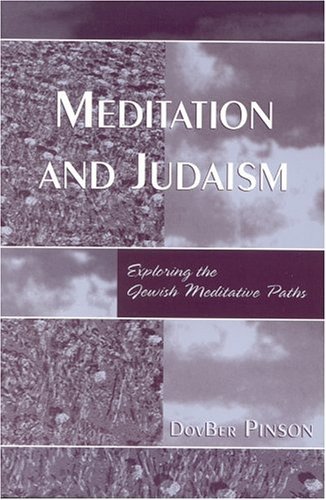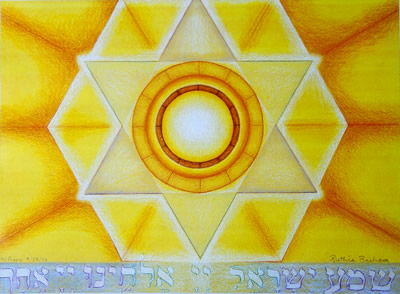
Patrolling the Borders of Truth:
Meditation and Judaism
Reviewed:
Dovber Pinson, Meditation and Judaism: Exploring the Jewish Meditative Paths
Rowan & Littlefield, 2005
During the bustle of last year's Limmud conference - one of the world's most celebrated Jewish educational gatherings - this magazine's chief editor, Jay Michaelson, who had just returned from six weeks of silent meditation, turned to me and commented: "This is like the opposite of a vipassana [insight meditation] retreat. Here everybody's running around seeing how many thoughts they can pack into their heads."
It is for reasons such as this that Judaism is little associated, in popular culture at least, with meditative techniques. We are a religion of accumulation: the individual accumulation of knowledge and deeds and the communal accumulation of history and texts. Conversely, meditation is usually a practice of reduction, an activity that pairs down the practitioner's mental clutter and wipes the metaphorical screen clear.
Thus writers like Rabbi DovBer Pinson, author of Meditation and Judaism: Exploring the Jewish Meditative Paths, and Rabbi Aryeh Kaplan before him, face a particularly difficult task: to show that Judaism does indeed have its unique, distinctive modes of meditation. Moreover, in a context in which most meditation is derived from Asian traditions, traditional teachers like Pinson and Kaplan are at pains to show what exactly makes those modes 'Jewish', and how they differ from the forms of meditation found in other traditions, particularly those of the 'East.'
 It is an understandable search for authenticity, though one fraught with complexity. First, expectations vary widely. Some people believe Jewish meditation should be authentic, homegrown, indigenous meditation practices, such as those Pinson describes in his books. Others, though, are seeking the same things they've encountered elsewhere, only given a Jewish slant through language and symbol. Still others are happy to continue their non-Jewish meditation practice, but within an embracing Jewish community.
It is an understandable search for authenticity, though one fraught with complexity. First, expectations vary widely. Some people believe Jewish meditation should be authentic, homegrown, indigenous meditation practices, such as those Pinson describes in his books. Others, though, are seeking the same things they've encountered elsewhere, only given a Jewish slant through language and symbol. Still others are happy to continue their non-Jewish meditation practice, but within an embracing Jewish community.
Of course, this variety makes sense. For example, in the case of mantra meditation, it is only natural that some people prefer to chant words from their own tradition (after all, Judaism has an ample selection of words to choose from) while others prefer other traditions' time-tested phrases.
But there are problems as well. In many cases, hybrid meditation invites the question of whether is it really 'Jewish meditation' and not an amalgam of tradition-neutral or borrowed meditation techniques, plus Jewish trappings. On the other hand, the need to find something exclusively 'Jewish', if taken far enough, can lead to a skewed approach which often seems marked by insecurity, defensiveness and unbacked assertion.
This need constrains Pinson's new book. "Meditation and Judaism" is, for the Jewish educator or student, a true treasure-trove of Jewish sources on meditation and mysticism, thick with references and footnotes mentioning primary texts. But it is marred by its unbacked generalizations about other traditions.
Pinson's treatment of Judaism and "paganism," and his alignment of the latter with some non-Jewish traditions, is an excellent example of the constraint and its consequences. In the chapter dedicated to 'The Ayin of Jewish Meditation Versus the Nothingness in Other Meditations,' Pinson claims that 'Eastern religions' teach the possibility and desirability of becoming "one with one's own true nature, and by extension, one with the whole of nature." Pinson labels this a pagan impulse, and contrasts it with Jewish emphasis on the transcendent. But is it true? Do "Eastern religions," in their manifold variety, really ignore the transcendent? And, for that matter, does Judaism really focus only on the transcendent, and not on "pagan" nature? Pinson does not offer proof; only a claim of a distinction, followed by an assertion of superiority.
The alleged distinction between Judaism and "paganism" is one which is longstanding in the Jewish tradition, of course, and has some fascinating consequences. Earlier in the same chapter, Pinson relates a Chassidic story of a Chassid who has been 'infected with Pagan spirits,' and is forced by his Rebbe to declare that he does not want to eat an apple, when really he desires it. The story ends when finally the righteous man loses his desire to eat the apple – but eats it nonetheless. According to Pinson, this is an example of how by "contravening his nature, he [the Chassid] liberated himself from the powers of nature, and by consuming nature (the apple), he became a master over nature".
Pinson's analysis flattens what is actually a complicated story about desire and its relationship with the self. Yes, perhaps the apple is linked with the forces of nature that represent pagan worship (the Chassid becomes infected when he passes a group of pagans in the woods). But on an inner level, when we look at what's going on within the Chassid himself, the story is not about 'nature' (a notoriously slippery term) but desire – the Chassid has an instinctual desire to eat the apple yet he is forced to practice forbearance. It is too blunt, too simplistic, to associate paganism with nature (both human and environmental) and Judaism with mastery of nature.
Moreover, Pinson presses the story into service against the atheistic 'religions of the East,' whom he sees as the philosophical heirs to paganism. Yet how does Pinson explain the central tenet of Buddhism as declared in one of the Buddha's Four Noble Truths, that desire is the cause of suffering and a bar to Enlightenment? How does he explain the eightfold path, which includes renunciation of desire exactly in the (arguably repressive) manner of the Chassidic story he cites?



Golden Calf
Jacob J. Staub
Israel on Campus
A Conversation with Sam Brody and Zach Gelman
Samaria for Rent
Margaret Strother-Shalev
Does Mysticism Prove the Existence of God?
Jay Michaelson
Patrolling the Boundaries
of Truth
Joel Stanley
The Wheel World
Dan Friedman
Archive
Our 700 Back Pages
Zeek in Print
Summer 2005 issue now on sale
About Zeek
Mailing List
Contact Us
Subscribe
Tech Support
Links
Limited Time Offer
Subscribe now and get
two years of Zeek for
25% off regular price.
Click this button
to purchase:
From previous issues:
Art at War
Whatever It Takes
What, me Tremble?
Bara Sapir
Aaron Hamburger
Jonathan Vatner